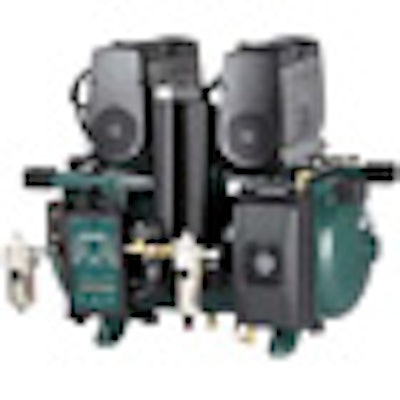
The newest compressor to hit the market, the RAMVAC Osprey by DentalEZ Group, addresses a potential issue that many practitioners many not be aware of: the potential for the spread of contamination from moist, compressed air.
Initially introduced at the 2012 ADA Annual Session in October, the Osprey officially hit the market on December 3.
"There was a study done at the Danish Technological Institute in Aarhus where they took random samples of compressed air from big dental clinics in these holding tanks," explained Ryon Waddington, senior product manager at DentalEZ Group, during an interview with DrBicuspid.com. "Upon testing, the amount of bacteria and viruses that were discovered within the receiver was pretty surprising. E.coli and salmonella were among them."
 The RAMVAC Osprey compressor. Image courtesy of DentalEZ Group.
The RAMVAC Osprey compressor. Image courtesy of DentalEZ Group.
Findings like this led the company to focus on two primary features to address the needs of a modern dental practice: hygiene and capacity.
"First and foremost, we made sure we had something that was going to be as durable and able to produce more than enough compressed air for the doctor to do dentistry because more and more items in practices utilize clinical air," Waddington said. "So if they have a hybrid handpiece that is both electric and air, the compressor would have enough to handle added psi [pounds per square inch] of that as well."
The increasing popularity of digital impressioning is a factor as well. "These milling machines that make teeth require air, and you get that from your clinical air," he said. "We want to make sure that when we size an existing practice, all of this is taken into consideration."
The result is a lock-in piston design that produces more usable cubic feet per minute than other compressors, with a maximum pressure of 115 psi, according to the company.
Virus- and bacteria-free
The designers also wanted the cleanest air possible, Waddington stated. Dual-dryer systems ensure 100% clean, dry, oil-free air. One side captures moisture while the other purges.
"We designed the Osprey system to have a dual-desiccant drying system where we can dry our air to a -40° C pressure dew point (the dew point of the compressed air in the receiver, different than an atmospheric dew point)," Waddington noted. "So not only can we make sure there isn't any airborne bacteria within the receiver, but it's also going to keep the clinical air lines free of that as well."
Part of the new design is a final 0.01 micron-rated filter downstream of the compressor.
"The air, as it passes through the receiver and into the clinic, will go through media that is fine enough to capture spores, pollen, bacteria, even some viruses," Waddington explained. "Basically, we're ensuring to the dentist that the air that the Osprey generates is going to be virus- and bacteria-free, the cleanest air on the market."
The attentiveness to cleanliness marks the next development in dental compressor technology, according to DentalEZ. Previously, the focus was on filtering out the oil from the airstream of lubricated compressors. That concern has been phased out over the last decade as the industry has moved away from those types of compressors.
While ensuring patients' health is the primary reason for the new design, it is forward-thinking in another way.
"There is an International Organization for Standardization (ISO) certification, while we're not certified to it, we meet that ISO," Waddington said. "In the U.S., we've always been about two to three years behind the European market when it comes to these certifications. We wanted to be first to market here in the U.S. with it."
Some European countries are expected to begin to hold compressor manufacturers accountable to the ISO standard, he added.
"I'm not saying that it's definitely going to be mandated, but in the event that it does, we're already there," he said.



















